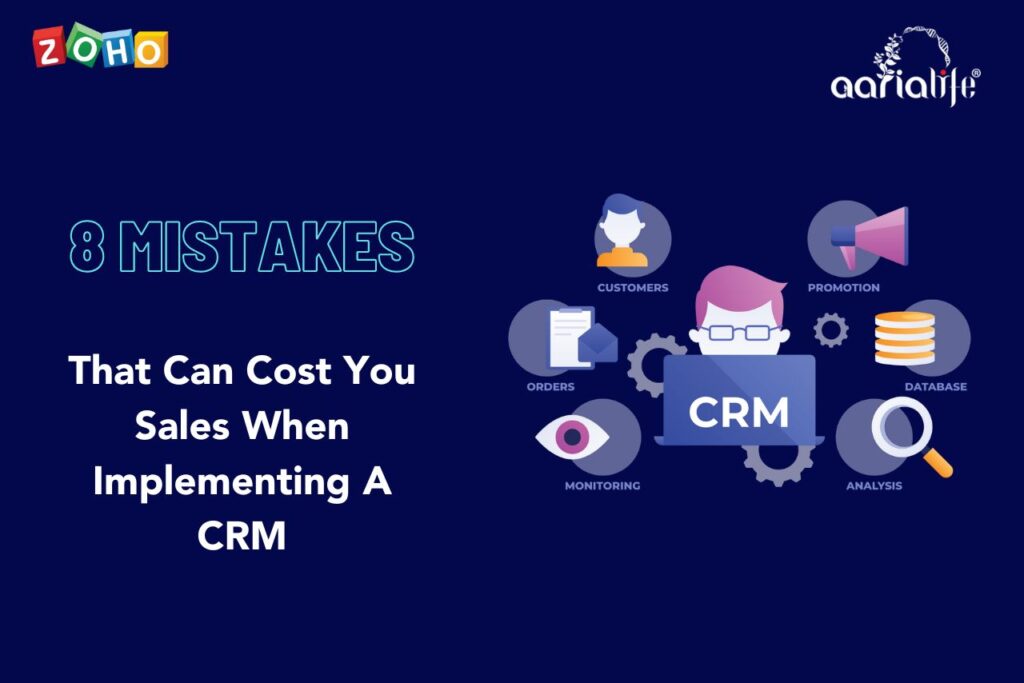Customer Relationship Management systems contribute to business growth by improving sales operations, but you must first determine your business goals. Having all of your customer data and sales activities in one place is the whole idea of investing in a CRM.
The most crucial requirement for the CRM structure to function properly is a successful system deployment. The efficacy of the online CRM system is influenced by a number of elements. To achieve a successful implementation, however, an efficient CRM solution must be in place. The right features, proper implementation, and appropriate third-party integrations all contribute to the effectiveness of CRM software. Right CRM has the potential to significantly improve customer satisfaction, customer retention and customer experience.
Frontline sales professionals don’t like CRMs, and they hate any system that pushes them to register, document, and pin their operations to a number. It’s also a fact that if the sales team doesn’t use the CRM, it won’t work. A CRM solution should be viewed as a powerful tool for increasing efficiency, automating repetitive tasks, improving business operations, increasing sales, and converting leads into potential customers.
Learn how to avoid CRM blunders which can cost and complicate your entire sales process in this blog.
8 Mistakes That Can Cost You Sales When Implementing A CRM
Do you have a plan to deploy Sales CRM in your company, or if you already have, are you looking for ways to boost your ROI?
A CRM solution is just as good as how it is used, and for new CRM initiatives, there may be difficulties along the road. Each year, a number of firms are drawn to new CRMs because of the underlying promise of the software. However, a sizeable portion of CRM projects fall short of expectations or don’t deliver the value promised to them; this is especially true of new CRM projects, which must navigate a lot of barriers and pitfalls along the way.
These 8 mistakes could ultimately harm the success of a CRM implementation process, from the viewpoints of both the implementation partner and the organization seeking implementation services.
Following that, eight common mistakes to avoid while implementing sales CRM-
1. Not having a Sales CRM Strategy
The first major blunder is implementing sales CRM without a well-thought-out plan.
It’s critical to recognize the distinction between CRM technology and CRM strategy. Most software companies that market sales CRM technology focus on how it can help increase salespeople’s productivity.
However, individuals who have worked in sales for a long time understand that selling is all about maintaining relationships with customers. At best, tools can help, but what matters is how well the sales representatives want to use them and what their goals are.
In summary, the key distinction is as follows:
CRM Technology: Serves as a central platform for organizing, using, securely sharing, and acquiring customer data. It has sales pipeline management and reporting features, as well as the ability to interact and track all of your contacts’ touchpoints and customer interactions (contact management).
CRM Strategy: A CRM implementation strategy is a collection of procedures that a business implements to standardize and optimize the use of CRM technology. The rollout process, communication mechanism, training, mentoring, and building a data-driven mindset among sales reps are all part of the approach.
Using a CRM also ensures that you identify who your most valuable customers are and that you have enough data to acquire more customers over time.
To get the most out of CRM technology, a company should start with a sales CRM strategy. Technology should support the plan rather than the other way around.
Whether you have a two-person team or a 200-person company, having a Sales CRM strategy is essential.
2. Not developing a clear sales process
The second implementation mistake is not devoting enough time to developing a well-defined sales process that is adhered to by the sales staff.
Sales CRM facilitates the sales process but does not enforce it. If your sales staff isn’t following a sales process, take the effort to create one and make sure everyone follows it.
The sales process is determined by the business’s level of complexity. It could be merely 5 steps out of a 15-step procedure. It is critical to define and obtain buy-in from the entire team.
Sales processes can be done considerably more effectively with CRM software like Zoho CRM than they can be done manually. Sales training and coaching are required to define the sales process and ensure that teams follow it.
The CRM is half-dead without a well-defined sales process, and it will most likely become just another sales tool for tracking activities rather than a business tool that can increase sales revenue. CRM offers a wide range of benefits for businesses. The CRM aid the business owner in better understanding the customer demands and behaviors of their customers, resulting increase in sales.
3. Knowing internal challenges
A third blunder is failing to recognize the internal challenges of sales CRM implementation. There will always be resistance from various stakeholders to adopting new technologies, particularly automation solutions such as sales CRM, which demand users to change their behavior.
Implementing a sales CRM system necessitates major changes in the way salespeople work. When it comes to forming new habits, a top-down approach will not work. The migration of sales CRM must first be approved at the sales force level.
Sales managers and salesperson would fight the transition not because they don’t want to utilize CRM, but because they lack the vision to see “how it benefits him in his work.”
To accomplish this, the sales staff will be better connected to the sales CRM project by improving critical skills through training and coaching.
Refer to our blog – Ten Tips On How To Make Your CRM Implementation A Success
4. Taking More Features Than Needed
Selecting and installing a CRM system without first determining whether your organization needs various features is a common mistake. Many customers do not take advantage of CRM’s services to their full potential.
You are not obligated to use the most advanced and feature-rich applications. Rather, you should determine the most appropriate characteristics for you depending on your company’s requirements. Check to see if everything is in line with your budget and goals.
Make a list of all the features you’d like to use before you start implementing. It will also be advantageous if you obtain input from your end-users by asking them about the workflow pinpoints that they wish to solve.
5. Choosing an incompatible system
As your company grows, you’ll need to invest in more sales and marketing automation solutions. Your business process will be more efficient if your CRM offers more seamless connectors. It will relieve you of a significant amount of stress. As a result, you should find out ahead of time if the CRM you intend to purchase has integrations and how these connections will be beneficial to you.
Keep in mind that CRM integration will alter your business strategy and sales strategy initially. It will provide advantages tailored to your customers while greatly enhancing your customer engagement.
6. Not maximizing the use of Mobile CRM
Mobile devices allow you to access a CRM at any time and from anywhere, which is the most significant advantage. This is a frequent CRM blunder made by many businesses. You must understand that mobile CRM allows you to stay on top of your responsibilities without having to sit in front of a computer all day.
When mobile CRM software isn’t used appropriately, it might slow down customer response time and raise the risk of missing vital customer updates. When compared to those who do not, most salesmen who utilize their mobile phones are able to reach their sales quotas.
The majority of teams who use mobile CRMs see an increase in overall productivity. You can go with a CRM system that has a great mobile CRM app and make sure your sales team installs and uses it. For example, the Zoho CRM mobile app.
Surprisingly, 65 percent of salespeople who use mobile CRM meet their quotas, compared to only 22 percent of those who don’t. According to research, 50% of teams using mobile CRMs increased their total productivity.
7. Failure to Maintain Clean and Accurate Data for sales
A CRM system’s client data is more like its lifeblood of any sales department. It’s critical that you transfer and keep accurate and up-to-date customer data in your online CRM system.
Despite knowing how critical this is, many organizations fall into the trap of keeping faulty data, which leads to inaccurate sales forecasts and outdated customer information. Companies wind up paying a lot of money because of all the missing, outdated, and incomplete data.
Organizations can prevent this by establishing a uniform data input procedure for the entire team to follow. For example, while building a new customer profile, the process of identifying essential fields that must be filled out in order to avoid duplications.
Full name, firm name, contact information (landline and mobile phone numbers), address, and social media profiles are all examples. Aside from that, you can set up frequent cleaning schedules for the maintenance system. When this is done on a regular basis, it can aid in the detection of duplicate or missing data, allowing urgent action to be taken to correct the situation.
8. Failure To Define And Measure KPIs
Many firms begin with unclear KPIs and inadequate tracking. You need measurable objectives and sales targets in order to assess the performance of your CRM and its return on investment. Establish your goals for the CRM project and choose the KPIs to gauge your sales productivity progress. Ideally, you should consider a number of KPIs from various angles. Regularly reviewing your progress will enable you to stay on track and take action when things don’t go according to plan.
Conclusion
CRM blunders can be quite costly. This has a financial impact, but it also results in the loss of valuable time and key customer data management. The good news is that thorough study into critical factors like recognizing the right features, properly integrating them, and following the deployment process will help you avoid frequent CRM blunders.
Hiring a CRM support and maintenance partner is one approach to assure a seamless adoption of this software solution. When you employ a team to implement CRM, they place a strong emphasis on analyzing your business requirements, customer journey, and overall business processes.
According to an infographic from Insight Management Consulting, internal human resources account for 64% of CRM implementation success, while external consultants account for 56%.
You may either think about all the mistakes listed above and avoid them, or you can perform a better job with the help of a Zoho partner. This way, potential difficulties in the future will be avoided for your company.
Related blog – How to implement Zoho successfully with a consulting partner in India.



